Wildlife is incredibly colorful – from the Mandarin Ducks to Toucans, Mandarin Fishes, and Love Birds, there is an infinite amount of color out there.
Amid all these bright hues, there are some animals that are all black.
All-black animals are also called melanistic animals. Melanistic animals have melanism – a mutation in which their body produces more melanin than usual.
Interestingly, many animals with melanistic variants have albino variants.
In some animals, melanism is adaptive. It helps some prey animals to hide better from predators, and at the same time, it improves the stealth of some predators.
In many cases, adaptive melanism can be transferred from parents to children since the trait is controlled by a dominant gene.
Now that you know a handful about melanism, let’s discuss some different kinds of melanistic animals in the rest of this article.
Table of Contents
Black Panther
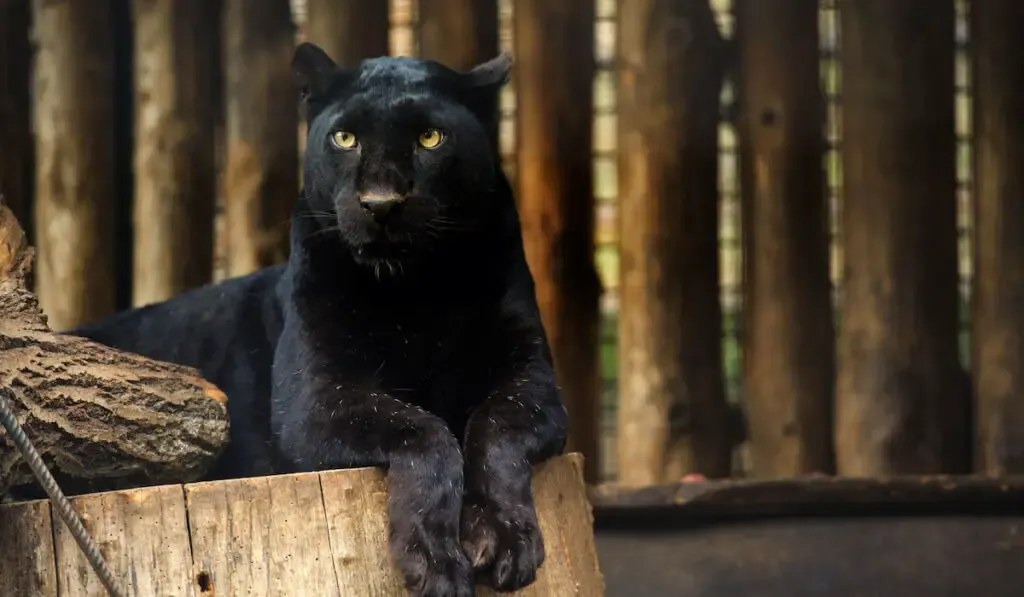
The Black Panther is one of the most popular melanistic animals.
Before you get in the Wakanda pose, it might interest you to know that the Black Panther is not a separate species of wild cat. It is actually the all-black variant of leopards and jaguars.
In Africa and Asia, Black Panthers are typically leopards with all-black coats. Then in South and Central America, Black Panthers are usually all-black jaguars.
Black Panthers are relatively uncommon. It is estimated that the highest possible rate of Black Panthers amongst the usual leopards and jaguars is 11%.
In leopards, melanism is controlled by recessive genes. However, that of jaguars is controlled by dominant genes.
While Black Panthers typically appear all-black, those with absolutely black coats are rare. In some cases, the exact details of the pattern of their fur are obscured by low-light conditions.
All-black wild cats like bobcats, cougars, lynx, and tigers may also be called Black Panthers.
However, the sighting of a melanistic cougar remains unconfirmed. Also, black-panther tigers are actually pseudo-melanistic.
Black Squirrel
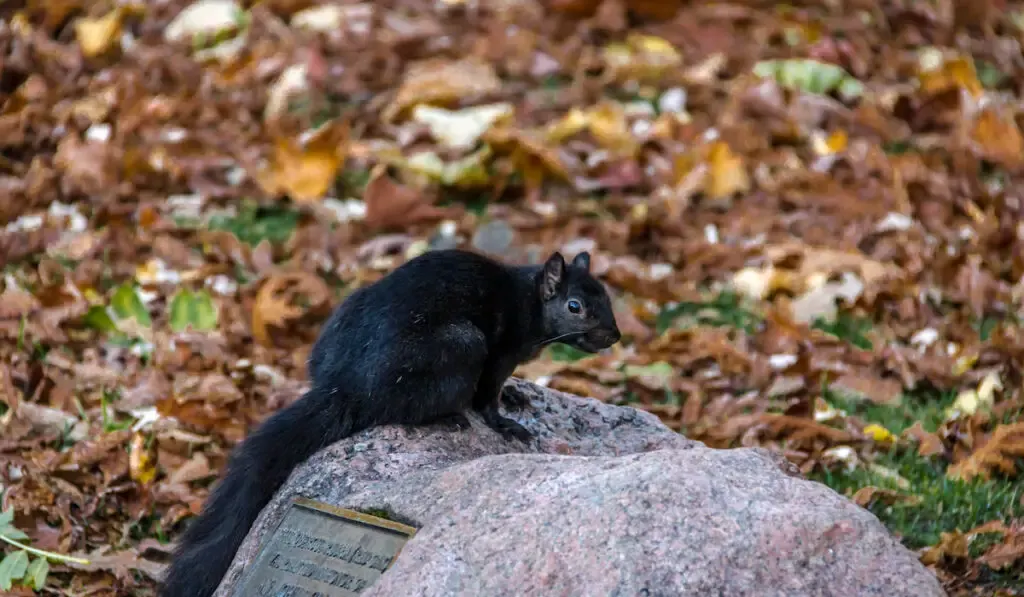
Melanism occurs in various species of squirrel. But it is more common in the Eastern Grey Squirrel and the Fox Squirrel.
It is thought that the mutated gene that birthed melanism originated in Black Fox Squirrel and was later passed to Eastern Greys through interspecies breeding.
Black Squirrels are typically found within the same range as normal-furred squirrels. However, they are very uncommon – more uncommon in some places than others.
It is estimated that 1 in 10,000 Eastern Grey Squirrels is melanistic – less than 1%.
Apart from making them unique, melanism has other benefits in squirrels. For one, it helps with concealment.
In areas with conifer trees, a lot of sunlight does not get to the forest floor, making it dimly lit. So, it is thought that melanistic squirrels conceal themselves better in such regions than non-melanistic squirrels.
It is also suggested melanism is an advantage for squirrels living in forests that go through periodic burning.
The idea is that since burning leaves behind a blackened area, the black squirrels blend easily and conceal themselves. Then again, a study suggested melanism can help camouflage a black squirrel in motion.
Besides helping with concealment, melanism helps squirrels with thermoregulation.
It is thought that black squirrels tolerate colder regions better than non-melanistic squirrels. They also have lower metabolic rates and experience lower heat loss.
Black Wolf

Melanistic wolves have been seen into wolf species – the Grey Wolf and the Red Wolf. Melanistic Grey Wolves still exist.
However, melanistic Red Wolves are now extinct.
Black wolves are uncommon in Asia and Europe. However, about a quarter of Italy’s wolf population is black.
You are more likely to find Black Wolves in North America. Places like Minnesota and some southern parts of Canada actually have more black wolves than white ones and in Wyoming’s Yellowstone National Park, about 50% of the reintroduced wolf population is black.
Black wolves occur more commonly in forested areas.
Their melanism is thought to offer them some advantage in that habitat – although the benefits have not been determined conclusively.
The gene controlling melanism is predicted to be dominant. One piece of evidence that supports this came from the breeding between a grey and a black wolf.
The two wolves in reference had an offspring of 14 wolves, and 10 of them were black.
Black Fox (Silver Fox)
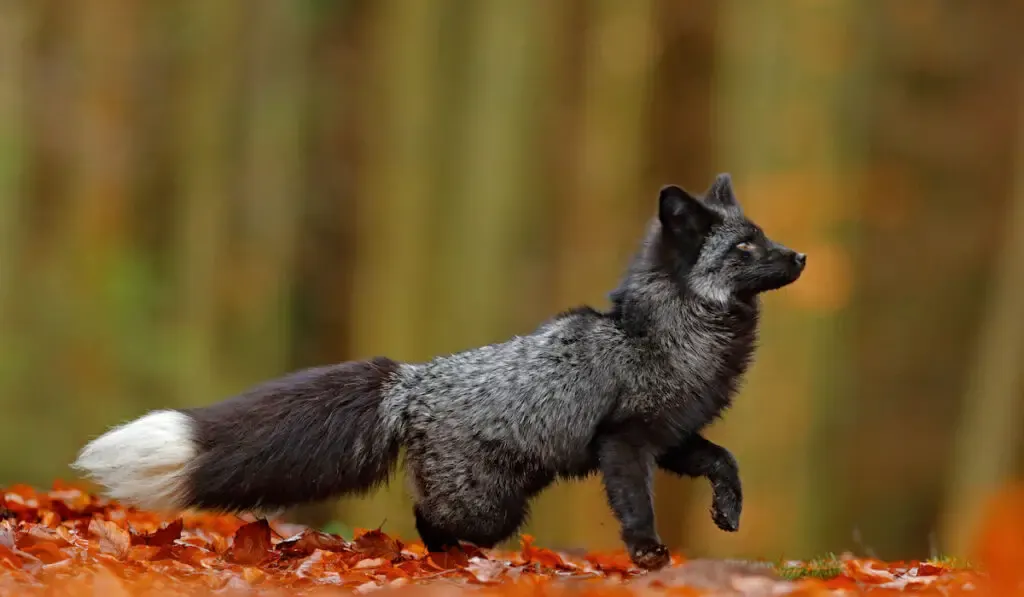
Black foxes are basically melanistic red foxes. They may also be called silver foxes because the black coats around their hindquarters sometimes have silver tips.
Like black wolves, black foxes are not common in Europe. However, they are common in North America, especially the United States.
It is estimated that about 20% of the foxes in North America are black, with Canada having an 8% black-fox prevalence.
Apart from being all-black, Black Foxes may also have grey or silver coats with black tips and it is not uncommon for black foxes to have white-tipped tails.
Black Rabbit

European rabbits come in various colors, and one of these many colors is all-black.
Melanistic rabbits are common in Mainland Europe, and they typically live on islands and large enclosures.
They choose to live in these areas because of the relative rarity of ground predators in such places.
Black Deer
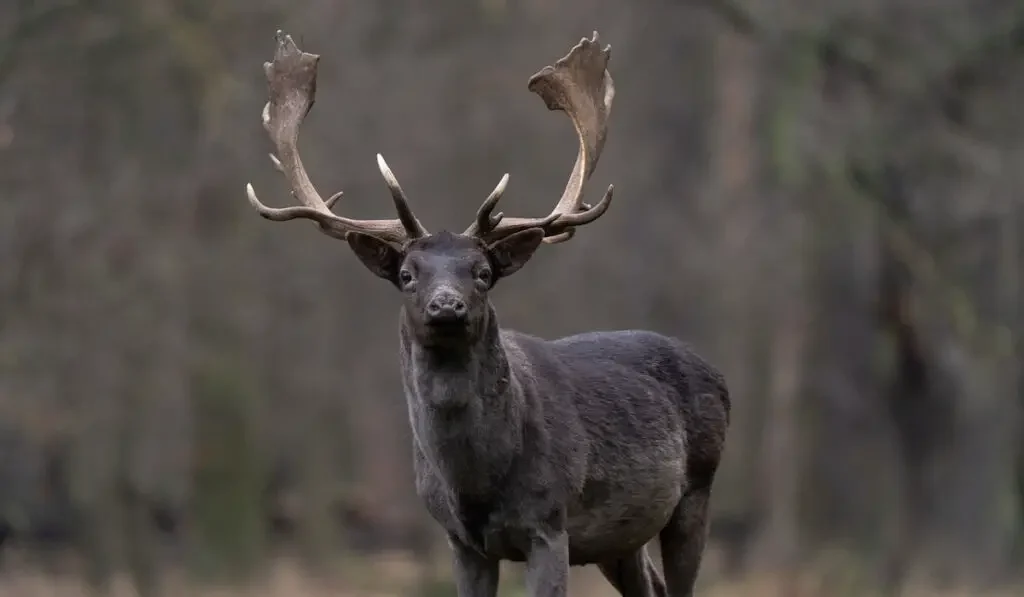
Apart from their usual brown coats, White-Tail Deer can also have white coats or black coats.
Both types of coats are rare, but black coats are the rarer of the two.
Black white-tail deer are melanistic, and the gene controlling this trait in them is a recessive one. They can either be all-black or dark-chocolate brown.
While black deer are not common, they have been spotted in at least 29 states of the United States.
The highest prevalence of black deer is said to be in an area in Texas. In this area, around 8.5% of the deer population is melanistic.
A group of non-native North American deer called sika deer has black or dark-brown coats.
However, it is not melanistic. From afar, it may look like a black white-tail Deer. However, when you get closer to a sika deer, you will realize it is smaller than white-tail Deer, and it has thicker fur.
Besides white-tail deer, melanism occurs in Fallow Deer. In fact, it is more common in this species of deer than in others.
This commonness of melanism in fallow deer may be a result of extensively breeding them in deer parks.
Melanistic Peppered Moth
Peppered Moths experienced a unique form of melanism called Industrial Melanism. Melanistic moths were first sighted in England around 1848 by R.S. Edleston.
This sighting was around the period of the Industrial Revolution in England. So, one of the theories put forward by scientists then was that the smoke from coal-powered industries darkened the moths.
Of course, it was later revealed that this darkening was the result of a mutation in moths. It was also revealed that the trait was transmissible.
Further studies were carried out to reveal why moths were becoming dark. One study showed that dark moths were less likely to be eaten than light moths in dim forests.
So, natural selection has been the prevailing explanation for melanism in moths.
Besides peppered moths, over 100 other moth species have been observed to become darker over time when in a polluted forest.
Black Turtles
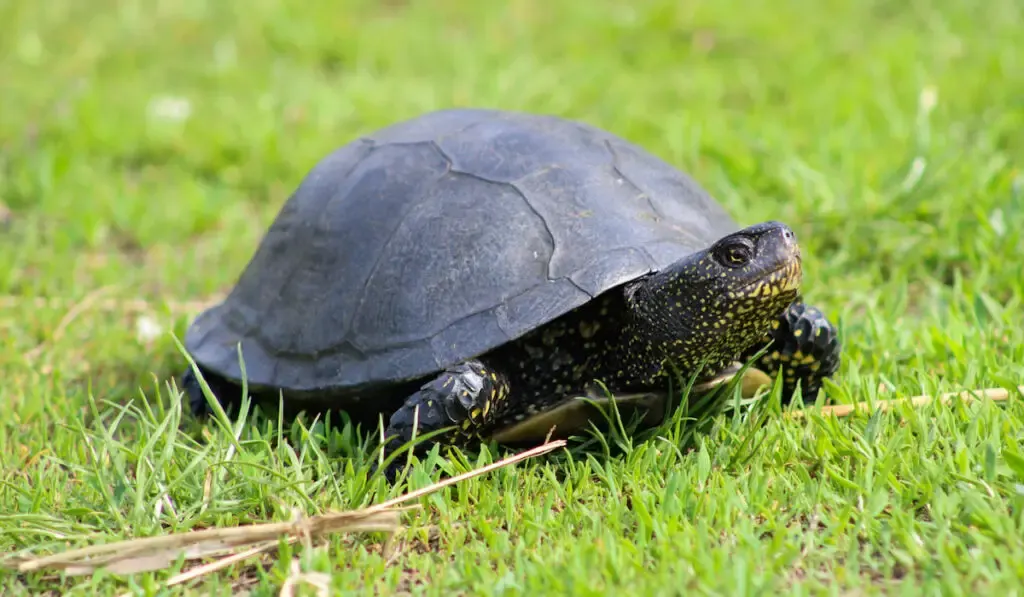
Melanism has been noted in male Red-Eared Sliders, and it is related to old age.
Unlike the males, female Red-Eared Sliders largely maintain their appearance all through their lives.
Black Serval Cat

Commonly, Servals have buff, tan, or golden-yellow coats with black spots.
But melanistic variants do exist. Black Servals have been seen in the wild and in captivity. However, as with many other melanistic animals, they are rare.
Melanistic Seal
Another animal that has an all-black variant is the grey seal. At birth, grey seals have white coats. But they molt when they are about 2-3 weeks old to reveal their new fur.
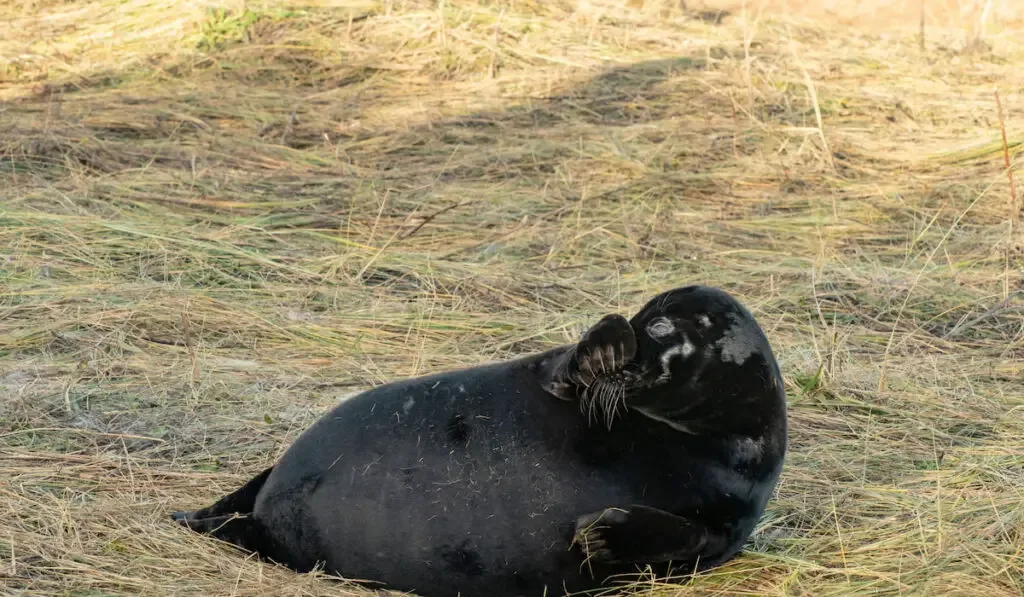
For a melanistic seal, this new coat is all-black.
It is estimated that 1 in 400 seals are melanistic.
Black Eastern Blue Tongue Lizards
The Eastern Blue Tongue Lizards also exhibits the melanistic trait in some individuals.
Alongside the usual colors, Eastern Blue Tongue Lizards are common in Australia, especially the eastern region.
Melanistic Guinea Pigs

Guinea pigs can also be melanistic, although rarely. In fact, in some cases, they are bred specifically to achieve the melanistic trait.
Ayam Cemani Chicken
Ayam Cemani is a chicken breed that is all-black. It is a rare type of chicken native to Indonesia.
But apart from Indonesia, you may also find them in the Netherlands, Germany, Czech Republic, and Slovakia.
Of course, because they are rare, Ayam Cemani chickens are pretty expensive. They can cost as much as $2,500-$5000.
Melanism in Ayam Cemani is controlled by a dominant gene. The comb, eyes, plumage, wattles, and feet of Ayam Cemani chickens are totally black.
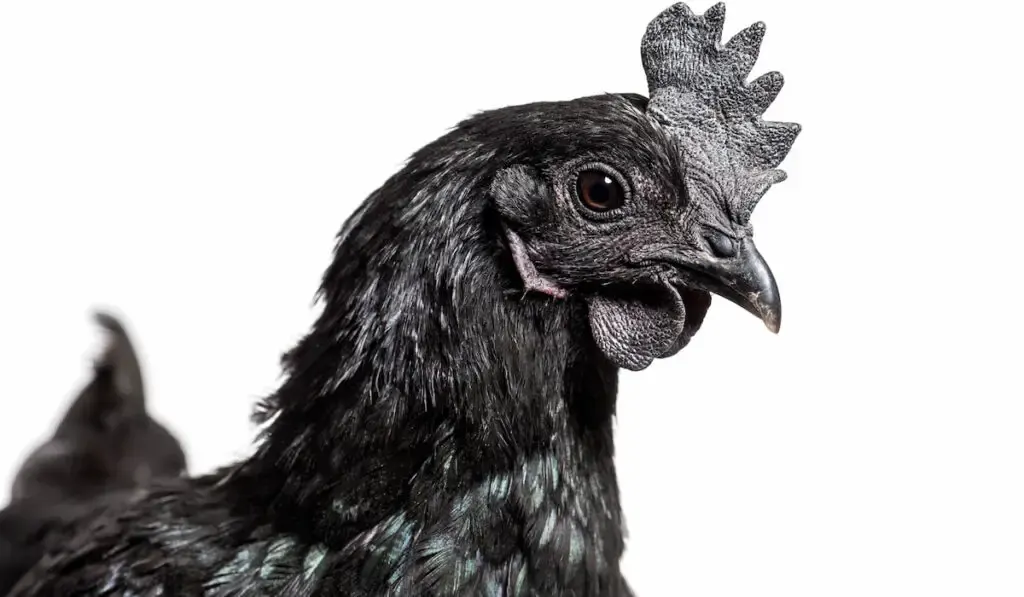
Ayam Cemani chickens are not generally large-sized. The roosters typically weigh 4.5-6.5 pounds, while the hens weigh 3.5-4.5 pounds.
In general, they are docile, friendly, and intelligent.
Ayam Cemani chickens are not excellent layers. They typically lay around 80 eggs in a year. Ayam Cemanis will lay about 20-30 eggs within a period, then stop a while.
The period during which they do not produce eggs can be as long as 6 months. This is one reason why they are primarily ornamental.
Unlike other animals we have discussed so far, Ayam Cemanis are only recognized as all-black. However, their eggs are white.
Gabar Goshawk Bird
Gabar Goshawks are usually grey with a white rump and a barred tail. But they also have melanistic variants.
Studies reveal that about 25% of the Gabar Goshawk in Swaziland are melanistic. In Namibia, the ratio is 10%, in Zimbabwe 15%, and in the South African Bushveld 11%.
Grey Gabar Goshawk chicks and Melanistic chicks have been found in the same nests a couple of times. This occurrence suggests that the trait might be controlled by a recessive gene.
Silkie Chicken
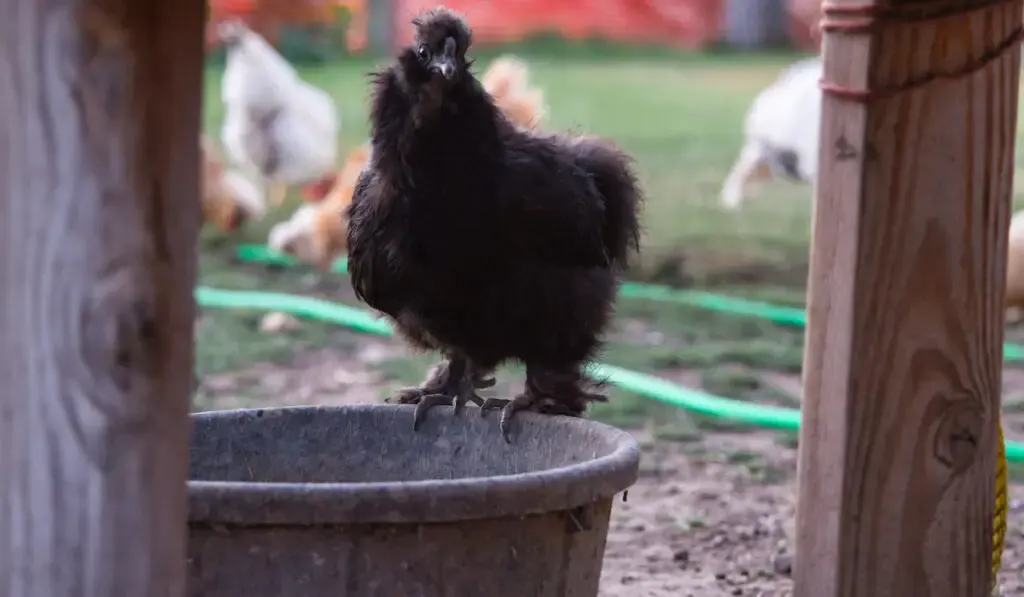
Silkies have plumage in various colors, including all-black.
Interestingly, every type of silkie has black or dark-blue skin. However, apart from having black flesh, black silkies have black plumage, feet, and faces.
The dark trait of the skin of a silkie is controlled by a dominant gene. Hence, its prevalence within the breed.
Melanistic Southern Right-Whale Dolphin
Southern Right-Whale Dolphins are usually white on their ventral region and black on their backs.
However, there is a melanistic variant. This variant lacks the usual white pigmentation on the ventral side.
Melanistic Manta Ray
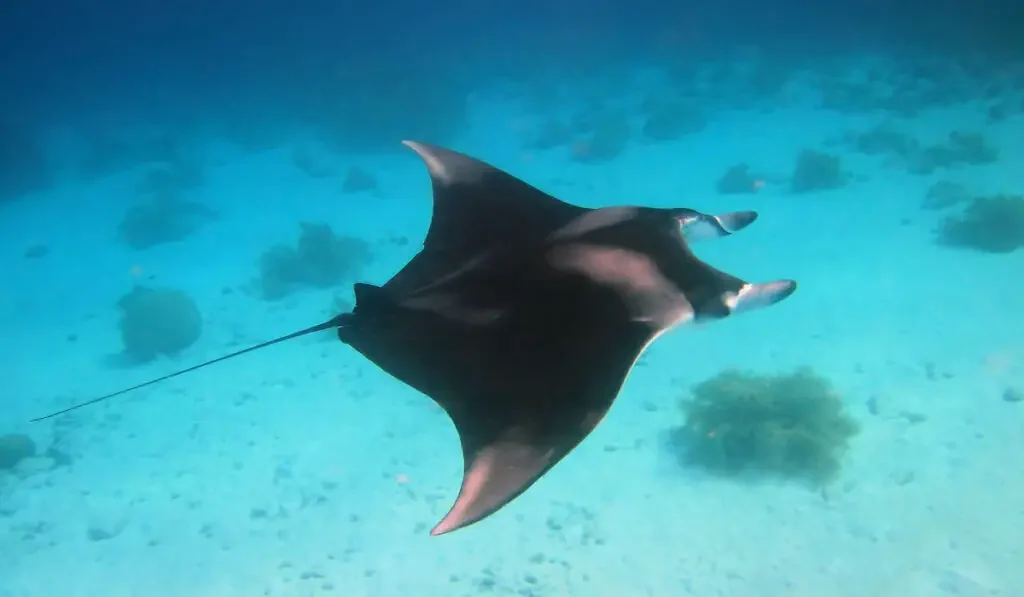
Manta rays typically come with white ventral sides and dark-grey dorsal sides.
But Melanistic Manta Rays have black dorsal areas and a ventral side that is almost totally black. However, they retain their unique central white blaze.
At the moment, it is not known whether melanism gives manta rays an edge over their predators. But this might change with further research.
Melanistic Kodkod
Kodkods are the smallest species of wild cats native to North, Central, and South America.
They are further grouped into two subspecies: tigrillo and guigna. The tigrillo subspecies – found in the southern region – has paler coats with no spots on its feet.
The guigna subspecies, on the other hand, is found in central Chile. It is relatively small-sized, and it has brighter coats with spots on its feet.
Kodkods typically have grey-brown to brownish-yellow fur with black spots. However, you may also find them in the melanistic form.
Interestingly, melanism in kodkods is not so rare. In some of them, you may even notice the spots under bright light.
Resources
- https://brightside.me/wonder-animals/16-melanistic-animals-that-are-the-truest-children-of-the-night-797847/
- https://twistedsifter.com/2012/02/10-incredible-melanistc-all-black-animals/
- https://www.britannica.com/animal/black-panther-mammal
- https://aru.ac.uk/news/interbreeding-turned-grey-squirrels-black-study
- https://academic.oup.com/jhered/article/105/3/423/2844022
- https://www.smithsonianmag.com/smart-news/interspecies-breeding-responsible-some-squirrels-black-coloring-180972921/
- https://www.masslive.com/news/2009/02/regions_black_squirrels_offer.html?category=Westfield
- https://www.ncbi.nlm.nih.gov/pmc/articles/PMC6625063
- https://animaldiversity.org/site/accounts/information/Sciurus_carolinensis.html
- https://web.archive.org/web/20081217112919/http://www.canids.org/species/Red_wolf.pdf
- https://www.newscientist.com/article/mg19926754.600-a-wolfs-dark-pelt-is-a-gift-from-the-dogs.html
- http://www.latimes.com/news/science/la-sci-wolves7-2009feb07,0,6843380.story
- https://www.sciencedaily.com/releases/2009/02/090205142137.htm
- https://www.safariltd.com/safaripedia/black-fox
- http://www.dnr.cornell.edu/ext/info/pubs/Wildlife/NYwildlife/red%20fox.pdf
- http://ekbooks.org/dandelions/wp-content/custom/electrolysis/rabbit-proof-fence-online.php
- https://blog.nature.org/science/2020/09/29/black-deer-have-you-seen-this-rare-color-of-a-common-animal/
- https://askabiologist.asu.edu/peppered-moths-game/natural-selection.html
- https://askabiologist.asu.edu/peppered-moths-game/kettlewell.html
- http://www.theturtlesource.com/i.asp?id=100200362&p=Melanistic-Red-Eared-Slider-(Adults)
- https://www.nationalgeographic.com/news/2017/03/black-serval-kenya-melanism-cats/
- https://books.google.com/books?id=B_07noCPc4kC&pg=RA4-PA181
- https://books.google.com/books?id=hFbJWMh9-OAC&pg=PA143
- https://www.edp24.co.uk/news/melanistic-seal-pups-oncamera-6912424
- https://www.amazingamazon.com.au/melanistic-blue-tongue-lizards.html
- https://www.roysfarm.com/ayam-cemani-chicken-farming/
- https://nedhardy.com/2020/06/24/what-does-ayam-cemani-taste-like/
- https://www.thehappychickencoop.com/ayam-cemani/
- https://ebird.org/species/gabgos2
- https://faansiepeacock.com/grey-is-the-new-black/
- https://silkie.org/black-silkie-chickens.html
- https://animaldiversity.org/accounts/Lissodelphis_peronii/
- https://www.tandfonline.com/doi/pdf/10.1080/00288330.2004.9517282
- https://marinemegafauna.org/field-updates/black-manta-rays-indo-pacific
- https://sites.duke.edu/bio205spring2020/2020/01/28/melanism-in-manta-rays/
- https://wildcatconservation.org/wild-cats/south-america/kodkod/
- https://tigertribe.net/small-spotted-cats-of-americas/kodkod-smallest-cat-in-americas/
- https://animaldiversity.org/accounts/Leopardus_guigna/
